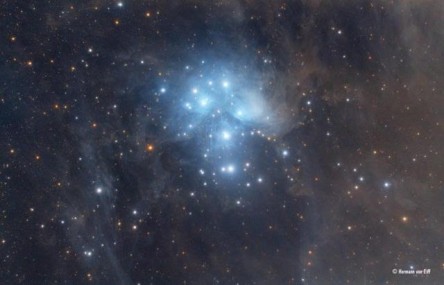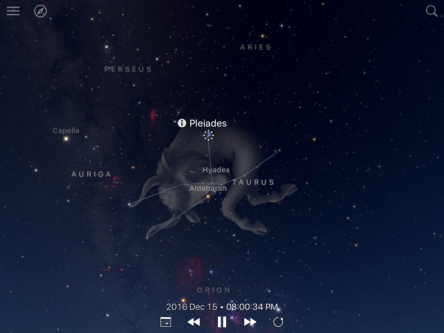THE PLEIADES STAR CLUSTER (MESSIER 45)
 In November I volunteered at the Central Arkansas Astronomical Society’s final star party for the year at Woolly Hollow State Park. Despite the chilly temperatures there was a decent sized crowd of about 30 or 40 people gathered around the various telescopes.
In November I volunteered at the Central Arkansas Astronomical Society’s final star party for the year at Woolly Hollow State Park. Despite the chilly temperatures there was a decent sized crowd of about 30 or 40 people gathered around the various telescopes.
During a lull in the observing I glanced off to the east to see a lovely sight just then rising over the tops of some trees, it was the Pleiades, also known to some as the Seven Sisters. This small grouping of six or seven stars is not particularly bright but our eye is easily drawn to it for some reason.
As usual, I had my trusty 10×50 binoculars around my neck and I immediately began to pull a few star party visitors off to one side to take a peek. One look through the binoculars and folks immediately began to ‘ooh’ and ‘ah’ at the transformation they were seeing. For what to the naked eye appeared to be just a few stars suddenly became dozens of sparkling celestial gems, cosmic diamond dust spread across the blackness of space.
ABOUT THE PLEIADES
Stars are born in clusters within vast clouds made up of cold molecular hydrogen and dust. When young stars “switch on” by initiating nuclear fusion within their cores the intense radiation they emit will blast away their nursery of gas and dust. As youngsters, stars will huddle together, all loosely bound to one another by their mutual gravity. But stars (including our own Sun and its retinue of planets) also orbit around the center of our Galaxy, a trip which may take hundreds of millions of years to complete, and as they do so they interact gravitationally with other stars and star clusters. This results in the cluster breaking up over time and each star striking out on its own. Astronomers have made the determination that the cluster is moving in a direction that corresponds to southern Orion in our sky. Come back in another 250 million years and the Seven Sisters will have fled the nest and dispersed themselves all about the Milky Way Galaxy.
The Pleiades is a relatively young cluster at about 100 million years of age, as indicated by the presence of a number of hot, blue stars. Blue stars are ones that contain at least three times the mass or more of our Sun. Such stars live short lives that are measured in millions of years as opposed to the billions of years’ lifespan of stars like the Sun. Looking at photos of the cluster you can’t help but notice a ghostly haze of nebulosity around the Pleiades. Is this a remnant of their stellar birth cloud? Not really, say most astronomers. This tenuous mist seems to be a patch of gas and dust that the Pleiades just happen to be passing through at this moment in time. But there is no denying that this nebulous veil only serves to add to the mystique of the Seven Sisters.
As to how far away are the Pleiades…well, our best estimate is around 444 light years. We hope to have a more confident number in the years to come when the European Space Agency’s GAIA Space Observatory collects better data. Here is something cool to think about while observing the Pleiades: if that distance estimate is accurate, then the light that you are seeing from them began their journey a few years before Galileo made his first telescopic drawings of them back in 1610. As Galileo observed the Pleiades there came the dawning realization that the universe must contain an “unfathomable” number of stars beyond the mere thousands that we can normally see with the unaided eye from dark enough skies.
HOW TO FIND THE PLEIADES
 To locate the Pleiades star cluster, you must first find the constellation of Taurus the Bull. It’s not that difficult with the aid of a good December star map obtained from an astronomy magazine or by using an app guide to the night sky. Finding the star Aldebaran, which marks the fiery red eye of the bull, and which shines brightly at an apparent magnitude ranging from 0.8 to 1.0, will allow you to make out the V-shaped pattern of faint stars forming the face of Taurus. From this point, let your eye wander a bit to the west of the bull’s face and there you will see a small, tight gathering of six stars (seven if you have exceptional eyesight) that appear to form a dipper-like pattern. From light polluted areas the cluster may appear as nothing more than a fuzzy patch of light upon the sky.
To locate the Pleiades star cluster, you must first find the constellation of Taurus the Bull. It’s not that difficult with the aid of a good December star map obtained from an astronomy magazine or by using an app guide to the night sky. Finding the star Aldebaran, which marks the fiery red eye of the bull, and which shines brightly at an apparent magnitude ranging from 0.8 to 1.0, will allow you to make out the V-shaped pattern of faint stars forming the face of Taurus. From this point, let your eye wander a bit to the west of the bull’s face and there you will see a small, tight gathering of six stars (seven if you have exceptional eyesight) that appear to form a dipper-like pattern. From light polluted areas the cluster may appear as nothing more than a fuzzy patch of light upon the sky.
After appreciating this lovely family of stars with just your unaided eye, be sure to then observe them with a pair of binoculars. This is when that seemingly small number of stars suddenly transform themselves into something rather magical. Dozens of these stellar beauties will suddenly come into view and it is a sight that I never get tired of. Why do I suggest a pair of binoculars rather than a telescope for viewing the Pleiades? Well, with just your unaided eye you cannot see that the cluster actually covers four full moon diameters upon our sky and most telescopes will only offer a very restricted field of view. Binoculars, with their larger FOV, will encompass much more of the cluster than your average telescope will. 7X binoculars will do just fine, but if you can locate a 10X pair then go for the gusto!
MYTHOLOGY OF THE PLEIADES
According to Greek mythology, the Seven Sisters were the offspring of the Titan Atlas and his wife Pleione, a nymph. Zeus, the king of the gods, had condemned Atlas to support the Heavens upon his shoulders for all eternity and naturally his wife and daughters were quite distraught with this turn of events. One day, while traveling through the forests of the world, the women came across Orion, the mighty hunter. He was a good looking guy but had a somewhat odious personality. Orion began to make unwanted advances upon Pleione and her daughters and he chased them across the globe for years. Pleione appealed to Zeus to intervene and he changed the women into doves so that they could escape from the boorish Orion. They flew as high into the sky as they could in order to elude him and there they are to this day as the beautiful little star cluster we all know and love.
Every culture in human history has had its own set of constellations and legends associated with them and a surprising number of them share the feature of having young women or boys gaining the ability to fly high up in the sky to become this odd little grouping of stars. I want to share another of these legends with you and it comes to us from the Cherokee, Native Americans originally indigenous to the southeastern United States. During the 1830’s the Cherokee Nation was forced to relocate to “Indian Territory” out west. This shameful treatment led to the famous Trail of Tears in which thousands of Cherokee were forced to march westwards for over 800 miles and, consequently, led to the tragic deaths of some 4000 people.
What we call the “Pleiades” the Cherokee called “Ani Tsutsa” (“the seven boys”). In the long ago world there were eight young boys who would much rather spend time playing a game that involved rolling rounded stones along the ground with long sticks than helping to work in the cornfields. One day their mothers became so angry with them that they decided to boil some of these stones in water as the boy’s supper- “If you like your game more than the cornfields then you shall only have stones to eat!” This made the boys very angry and they stormed off only to sullenly gather together around the Council House. The boys decided that they would pray to the spirits to give them the ability to fly away and escape their mothers. They began to dance around the Council House as they implored the spirits to grant them their wish. Before they knew it they were lifting off from the ground. Their mothers, sensing that something was wrong, arrived at the Council House only to witness the terrifying sight of their children drifting away from the Earth. One mother was able to leap up, grab her son and pull him back to the ground. But he struck the ground with such force that the Earth opened up and swallowed him whole. The other boys continued to climb ever higher until they became that group of stars known as the Ani Tsutsa.
The mother whose son was taken by the Earth would return to the spot day after day and weep for him until the very ground was wet with her tears. One day, the people noticed a tender green shoot emerging from the soil where the boy was taken. The mother continued to water the shoot with her tears and it eventually became the tree that we call the “pine”. It is said that the pine, a sacred tree to the Cherokee, is of the same nature as the stars and holds within it the same bright light. This bit about a bright light probably refers to the fact that cured pine wood contains a concentration of flammable resin known as “fat lighter”. It may also be a reference to the fact that both stars and pine trees appear to be eternal. The pine is always green while the stars seem to shine brightly for all time. So, the Cherokee myth of the Ani Tsutsa serves double duty as both a moral fable and as an explanation for something we see in the natural world.
The Pleiades are always a fine sight on these frosty winter evenings and I urge you to step outside and get better acquainted with this delightful group of stars.